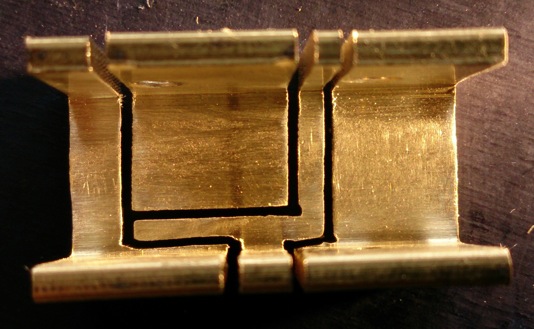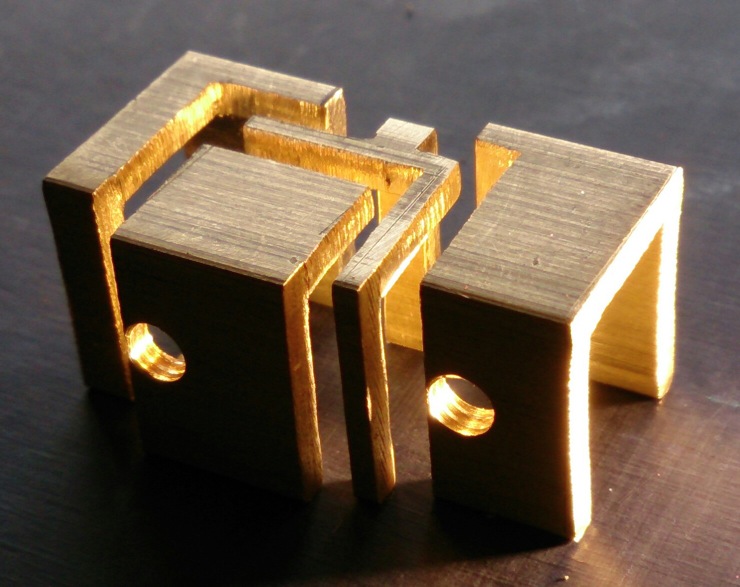Hi, yesterday I finally had a full day at home with the family away, so I started on the overdue from-scratch-build. I entered the competition in the hand-made category, but did not have any serious time to build it until now. It is a complicated variation of a 9V light I built a few years ago with a Luxeon Rebel inside, and I have no idea if it will work in the end. It is all pretty small stuff (although not as small as what RufusBduck does) and I tend to always mess initially nice ideas up and come up with a sloppy end-result. So be it  .
.
I formed the ideas when the contest was annouced in june and wrote up the design. The final design is the one with the arrow, some parts that i wanted to use are around it:

The terrible thing about this design is that it has hardly any heat-dissipation, and I could not think of a nice way to incude it because any seriously usable finning would make this light big and ugly. So I see this built just as a challenge; can it be done the way I want it?
And because I do not have abide the hand-build rules of the competition I can use these 
 :
:

No fancy lathe-stuff or anything, but it does make life a bit easier :-)
Ok, I started off with some brass profile, measured the places where the holes would be, drilled the holes and hand-tapped the threading:

Unfortunately I did not have the 3.3mm drill bit for the M4 screwholes, so I used 3.5mm. The threading is quite loose now (here I go already, sloppy from start :-( ). Well, it is not unlike the threading of many chinese flashlights :-) . Here's a picture of the tapping in action:

I sawed the bit a wanted to use, drawed where the saw cuts should be, and fitted some leds in place (that is, on the outside, they will be on inside finally, and the two outer leds will be different ones). And it appeared I had done some wrong assumptions in the design: the Nichia219 was not 3mm square but 4mm, and the MT-G2 (it is a 2700K 90 CRI one) was not 10mm square, but 9mm. Had to correct some lines.

I did as many cuts as possible with the bandsaw, but I could not have finished it without the good old fretsaw :-)

This is the little 3D-puzzle that came out:


Or, with some fancy lighting:
 djozz(2013) 'no title'
djozz(2013) 'no title' 
I had to make two raised bits for the 'screw switches' to make contact:


I sawed little rounds from some messing I had around and filed two notches to shape. I put some solder paste under the little rounds and used a small blow-torch to solder it together. then I sanded it flat and into shape:

So far, so good, and now on to something I wasn't comfortable about at all: the reflowing of the leds. I could not think of another way than just reflow everything in one go, but that would be nerve-wrecking, and I needed a separate carrier to assemble it all on, put it on the hotplate and keep everything still when removing it again. So I sanded a bit of aluminium nice 'n flat and off I went:

The block at the bottom is the hotplate (a converted 12V solder iron connected to a adjustable power supply), the block on top is cold, the assembly is on a aluminium slider.
For those who like to see me fumbling on the square mm, I made a video of the first attempt:
The result of the first attempt being that everything sticked together quite neatly, but when connecting a 9V battery just the two outer leds lit up (I was lucky that they did not blow). Apparently under the MT-G led it shorted. So I tried again and again, and an hour later it looked acceptable again, but when connecting the battery: nothing, no led lit up at all! I did check before placing the led which side of the MT-G2 was the plus (there are no visible clues on the led unfortunately), but now I doubted that, so I removed the MT-G2 and checked,  ouch, it was indeed reversed, how did I manage that?? So I placed it correctly and went on with the fiddling and fumbling. Eventually I ripped off the solder pad of the Nichia, so having no spare one I decided on replacing it with an old XM-L from the spare-led box, being a bit bigger it would hold the pieces of brass together a bit better as well. Finally, after two and a half hours of trying and error and at least 6 heating sessions (I feel sorry for the leds
ouch, it was indeed reversed, how did I manage that?? So I placed it correctly and went on with the fiddling and fumbling. Eventually I ripped off the solder pad of the Nichia, so having no spare one I decided on replacing it with an old XM-L from the spare-led box, being a bit bigger it would hold the pieces of brass together a bit better as well. Finally, after two and a half hours of trying and error and at least 6 heating sessions (I feel sorry for the leds  ), I ended up with this, not quite as neat as planned, but it stayed one piece and looked like it could work:
), I ended up with this, not quite as neat as planned, but it stayed one piece and looked like it could work:

And work it did  (victory!):
(victory!):

The three leds in series create a nice moonlight, probably the only mode of which the heat can really be handled by this light  .
.
So to bed I went, had a bad night without much sleep, and this morning, with a proper headache, I did some smelly chemical polyester casting on the assembly (to make sure the headache lasts for the whole day  ). I first smeared the screws with (waxy) mold release agent and screwed them in place (to keep the screw holes open during the casting), I have never done such a thing before, I hope it works, and that I can get the screws out again after the setting of the polyester.
). I first smeared the screws with (waxy) mold release agent and screwed them in place (to keep the screw holes open during the casting), I have never done such a thing before, I hope it works, and that I can get the screws out again after the setting of the polyester.

Now a little plastic container was made from an old blister packaging, and some polyester resin was mixed with hardener and stirred well.

A small layer was poored in the container and the led assembly was slowly placed.

And then slowly the rest of the polyester mix was poored (I did not need the syringe it appeared) and the container was covered with another piece of the packaging (polyester hardens less well near air contact).


As you can see the polyester has a refractive index quite close to the silicone :-)
And now wait for a few days to let the polyester harden well. In fact it may take me two weeks before I have the time to continue on this.
I really hope that the light is going to work in the end...




 ....
....